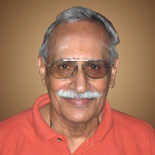|
Go to Part 53 IV - Does not the enquiry “Who am I?” reveal the self? Another view that is prevalent among the devotees of Ramana Maharishi of Tiruvaëëämalai is that the inquiry “Who am I?” conducted by a person will make the mind go back to its source and that if this state of inwardness (antar-mukhatvam) is maintained, the “I” which is the source of all thoughts will go and that the self which ever exists will shine.
This method of knowing the truth of the self does not stand scrutiny [334]. Let us consider the situation where the rope is mistaken to be a snake. Here, object-awareness plus ignorance-born mistake of taking the object, which is a rope, as a snake becomes snake-knowledge. Similarly, I is sat-cit-änanda but this self-evident I with the ignorance of I is ahaìkära, the I-notion. There are, however, not two ‘I’s but only one I which is either correctly or incorrectly known. The I that is with memory, biography etc. is not the real I, as it is merely a concept and is nothing but a thought, which is illumined by consciousness. It is different from all other thoughts and keeps on gathering new notions. In addition to the I-thought, we have the object-thoughts, which are centered on the I-thought. When these thoughts are absent, the mind is peaceful; but the I-thought remains.
The I-thought will not go in spite our doing anything to be free from it. For instance, it will remain as, ‘I am a yogé’ or ‘I have surrendered to Éçvara’ or ‘I am spiritual’ or ‘I am a sannyasi’ or ‘I am a bhakta’. It always gathers a new qualification to remain there. The I-thought is born of ignorance and it will go only through knowledge. It is like the snake that will resolve into rope only on rope-knowledge.
As regards self-inquiry as the solution, the incorrectly known I cannot conduct the enquiry on itself to rectify the error. It must be dealt with from the outside base of knowledge. That can only be the teaching from a competent guru. Otherwise the notion, ‘I am the enquirer’, will persist and the only result would be that the I-thought would get a new lease of life. Teaching “tat tvam asi” is the brahmästra [335] and it works when the guru uses it on a receptive mind. When it is exposed to the teaching, the enlightened self replaces the erroneous I-notion. The expression, mano-näça or the destruction of the mind means only the dropping of the erroneous I-notion born of ignorance in the wake of knowledge.
V - Is it not necessary to remove väsanäs to gain mokña?
Some hold that our problem is that ätmä is polluted and that it can be brought to its original nature only by cleansing it. One system concerns itself with whatever has been accumulated over the previous janmas called as väsanäs [336]. These are retained impressions and are equated with the results of all past actions. It is held that their exhaustion is necessary for knowing the self.
This misgiving is baseless as ätmä is the only reality. There exists no other real entity for ätmä to be affected by it. As for väsanäs, they themselves depend upon ätmä for their existence. They are mithyä. If these facts were understood, it would be clear that väsanäs can never pollute ätmä. Even if we assume that it does so, it is not possible for anyone in a given incarnation to exhaust the väsanäs collected in an infinite number of lives.
The çästra does mention exhaustion of väsanä. The väsanäs that the later äcäryas talk about are with reference to the mind and they are three fold. The first is the fascination for an object (viñaya-väsanä) born out of the thinking that it can give us security and happiness. By vicära, we have to remove this from the mind to become eligible for self-knowledge. The second is the ‘I-am-this-body-väsanä’ (deha-väsanä) and it has to be removed by inquiry and contemplation based on knowledge. The third väsanä is the craving for the study of çästra other than Vedänta (çästra-väsanä) and it has to be tackled by discrimination and commitment to Vedänta-vicära. This three-fold väsanä is not presented by the äcäryas as a cause for ätmä to become a jéva since ätmä has never become a jéva. Jévatva or the notion of being the limited individual has arisen owing to ignorance of the self and the pursuit is therefore to be an eligible seeker and gain knowledge from the guru that the svarüpa of ätmä is free from jévatva.
334. Section IV is based essentially on Swami Dayananda, Talks on Upadesa Saram of Ramana Maharishi, pp. 95 -98. Go to Part 55
|
|||
|
|||


www.advaita.org.uk
Advaita for the 21st Century



Vedanta - Part 54
VEDĀNTA the solution to our fundamental problem
D. Venugopal

D. Venugopal is a student of Swami Paramarthananda and a direct disciple of Pujya Swami Dayananda. He has successfully completed the long-term residential course in Vedanta and Sanskrit conducted from May 2002 to July 2005 at the Arsha Vidya Gurukulam, Anaikatti.
Go to CONTENTS
Biography
Buy from Amazon UK
. Available from Bharatiya Vidya Bhavan centers at London, New York and Sydney.
. Also through the IBH Books & Magazines Distributors Pvt. Ltd. - contact contact@ibhworld.com. In case of difficulty,pvsankarankutty@bhavan.info can be contacted.
BOOK DETAILS
Publisher: Bharatiya Vidya Bhavan
ISBN: 978-81-7276-457-9
Format : Paperback
Pages: 324
List Price: US$7.00
Where to Buy
AUTHOR DETAILS

